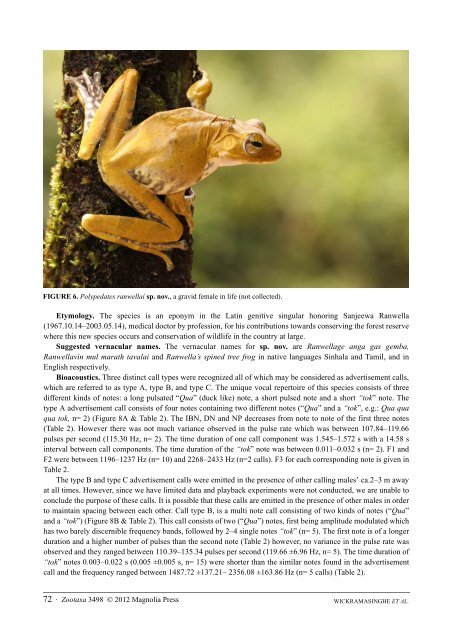Identification of Novel Species by Herpetological Foundation of Sri Lanka in Collaboration with Dilmah Conservation
Dilmah Conservation in collaboration with Herpetological Foundation of Sri Lanka has implemented a project on identification of new species of Herpetofauna, which will generate scientific evidence on their existence and promote conservation. This is the article published in Zootaxa Journal on the first new species identified as result of this research project – a species of Polypedates Tschudi …
Dilmah Conservation in collaboration with Herpetological Foundation of Sri Lanka has implemented a project on identification of new species of Herpetofauna, which will generate scientific evidence on their existence and promote conservation. This is the article published in Zootaxa Journal on the first new species identified as result of this research project – a species of Polypedates Tschudi …
Create successful ePaper yourself
Turn your PDF publications into a flip-book with our unique Google optimized e-Paper software.
TERMS OF USE<br />
This pdf is provided <strong>by</strong> Magnolia Press for private/research use.<br />
Commercial sale or deposition <strong>in</strong> a public library or website is prohibited.<br />
FIGURE 6. Polypedates ranwellai sp. nov., a gravid female <strong>in</strong> life (not collected).<br />
Etymology. The species is an eponym <strong>in</strong> the Lat<strong>in</strong> genitive s<strong>in</strong>gular honor<strong>in</strong>g Sanjeewa Ranwella<br />
(1967.10.14–2003.05.14), medical doctor <strong>by</strong> pr<strong>of</strong>ession, for his contributions towards conserv<strong>in</strong>g the forest reserve<br />
where this new species occurs and conservation <strong>of</strong> wildlife <strong>in</strong> the country at large.<br />
Suggested vernacular names. The vernacular names for sp. nov. are Ranwellage anga gas gemba,<br />
Ranwellav<strong>in</strong> mul marath tavalai and Ranwella’s sp<strong>in</strong>ed tree frog <strong>in</strong> native languages S<strong>in</strong>hala and Tamil, and <strong>in</strong><br />
English respectively.<br />
Bioacoustics. Three dist<strong>in</strong>ct call types were recognized all <strong>of</strong> which may be considered as advertisement calls,<br />
which are referred to as type A, type B, and type C. The unique vocal repertoire <strong>of</strong> this species consists <strong>of</strong> three<br />
different k<strong>in</strong>ds <strong>of</strong> notes: a long pulsated “Qua” (duck like) note, a short pulsed note and a short “tok” note. The<br />
type A advertisement call consists <strong>of</strong> four notes conta<strong>in</strong><strong>in</strong>g two different notes (“Qua” and a “tok”, e.g.: Qua qua<br />
qua tok, n= 2) (Figure 8A & Table 2). The IBN, DN and NP decreases from note to note <strong>of</strong> the first three notes<br />
(Table 2). However there was not much variance observed <strong>in</strong> the pulse rate which was between 107.84–119.66<br />
pulses per second (115.30 Hz, n= 2). The time duration <strong>of</strong> one call component was 1.545–1.572 s <strong>with</strong> a 14.58 s<br />
<strong>in</strong>terval between call components. The time duration <strong>of</strong> the “tok” note was between 0.011–0.032 s (n= 2). F1 and<br />
F2 were between 1196–1237 Hz (n= 10) and 2268–2433 Hz (n=2 calls). F3 for each correspond<strong>in</strong>g note is given <strong>in</strong><br />
Table 2.<br />
The type B and type C advertisement calls were emitted <strong>in</strong> the presence <strong>of</strong> other call<strong>in</strong>g males’ ca.2–3 m away<br />
at all times. However, s<strong>in</strong>ce we have limited data and playback experiments were not conducted, we are unable to<br />
conclude the purpose <strong>of</strong> these calls. It is possible that these calls are emitted <strong>in</strong> the presence <strong>of</strong> other males <strong>in</strong> order<br />
to ma<strong>in</strong>ta<strong>in</strong> spac<strong>in</strong>g between each other. Call type B, is a multi note call consist<strong>in</strong>g <strong>of</strong> two k<strong>in</strong>ds <strong>of</strong> notes (“Qua”<br />
and a “tok”) (Figure 8B & Table 2). This call consists <strong>of</strong> two (“Qua”) notes, first be<strong>in</strong>g amplitude modulated which<br />
has two barely discernible frequency bands, followed <strong>by</strong> 2–4 s<strong>in</strong>gle notes “tok” (n= 5). The first note is <strong>of</strong> a longer<br />
duration and a higher number <strong>of</strong> pulses than the second note (Table 2) however, no variance <strong>in</strong> the pulse rate was<br />
observed and they ranged between 110.39–135.34 pulses per second (119.66 ±6.96 Hz, n= 5). The time duration <strong>of</strong><br />
“tok” notes 0.003–0.022 s (0.005 ±0.005 s, n= 15) were shorter than the similar notes found <strong>in</strong> the advertisement<br />
call and the frequency ranged between 1487.72 ±137.21– 2356.08 ±163.86 Hz (n= 5 calls) (Table 2).<br />
72 · Zootaxa 3498 © 2012 Magnolia Press<br />
WICKRAMASINGHE ET AL.















